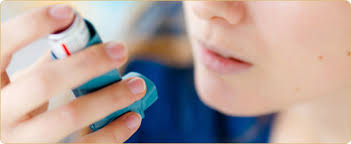
When people with asthma get respiratory infections, it can set off their asthma symptoms.
To reduce your risk of asthma symptoms, the best action you can take is to follow these simple asthma management steps:
- Keep taking your preventer inhaler daily as prescribed. This will help cut your risk of an asthma attack being triggered by any respiratory virus, including coronavirus.
- Carry your reliever inhaler (usually blue) with you every day, in case you feel your asthma symptoms flaring up.
- Download and use an asthma action plan to help you recognise and manage asthma symptoms when they come on.
- Start a peak flow diary, if you have a peak flow meter. If you don’t have a peak flow meter, think about getting one from your GP or pharmacist, as it can be a good way of tracking your asthma and helping to tell the difference between asthma symptoms and COVID-19 symptoms. It can also help your medical team to assess you over the phone or video.
- If you come down with flu, a cold, or any other respiratory infection, follow our tips for looking after your asthma when you’re not well.
- If you smoke it’s vital to quit now as smoking will increase your risk from COVID-19. There’s NHS advice on how to give up smoking here.
What is a high daily steroid dose for different inhalers?
Dose lists are available from the British Thoracic Society’s guideline on asthma management. If your inhaler is not listed, it may not be able to be prescribed at a high dose. If you think you might be on a high dose and your inhaler is not listed here, you can contact your asthma nurse or pharmacist for advice.
Social distancing advice for everyone not in the very high-risk groups
The Government has strongly advised that everyone reduce the amount of contact they have with others. This is called “social distancing” and it helps cut down the spread of the virus.
If you have asthma and have no symptoms of COVID-19:
- Avoid unnecessary interactions with other people. This means avoiding large gatherings, shaking hands with people or hugging them, and unnecessary travel, especially on public.
transport. You should also avoid going to public venues like bars, restaurants and cinemas. If it’s possible in your job, try to work from home. - You do NOT need to stay inside your house at all times or self-isolate. You can go to work if you are a key worker, for a walk, or to the park, or to the shops if you need to buy things. If you go out, stay 2 metres (3 steps) away from other people.
- Carry on taking all your usual asthma medicines as normal.
- If someone you live with develops symptoms of COVID-19, you will need to stay in your home for 14 days.
If you have asthma and you DO have symptoms of COVID-19 (a new continuous cough or a fever):
- You need to stay in your home for 7 days if you live on your own, or 14 days if you live with others. Everyone in your household will need to stay in the house for 14 days.
- You don’t need to contact 111 to tell them you are staying at home.
- If your COVID-19 symptoms don’t go away after 7 days, or get worse, or you are having difficulty breathing, call 111 for advice, or 999 if you need emergency care.
- Tell them that you have asthma, and if your asthma symptoms are getting worse.
- If you get an asthma cough and are not sure whether your cough is a symptom of COVID-19 or related to your asthma, please speak to your GP, use the online 111 service or call 111 to ensure that you get the right care.
- Keep following your asthma action plan to manage your asthma and so you know what to do if your asthma symptoms get worse. If you are having an asthma attack, call 999 for an ambulance as usual, and tell them you have COVID-19 symptoms.
- Carry on taking all your usual asthma medicines as normal.
Make sure you can get what you need
You should make plans to help you cope if the spread of the virus causes significant disruption, or if you get symptoms and need to self-isolate. This might include making sure you know how you would get your medicines, food and other essential items if you had to self-isolate, and thinking about how you would stay in touch with friends and family. You should register with your GP surgery for online services like ordering your prescriptions.
Please see the NHS advice on staying at home for more information.
Shielding advice for very high-risk groups
On March 22nd the Government has released new guidelines for people who are at high risk of needing critical care if they catch coronavirus.
We strongly recommend you follow this guidance if you are in one of the high-risk groups.
We have had more specific guidance from the Department of Health and Social Care about who is in the high-risk groups. Based on this, our clinical leads have helped us to create the following list, which should help you work out if you are in the high-risk group or not. This list is the best information we have at the moment about who is at high risk. We will update it if we get any new information or if the guidance changes.
If you are, or your child is, taking:
- Any biologic therapy, also called a mAb (Xolair/omalizumab, Nucala/mepolizumab, Cinqaero/reslizumab, Fasenra/benralizumab)
- Steroid tablets or liquid every day
- Antibiotic tablets or liquid for asthma every week (e.g. azithromycin)
- Tiotropium
- A combination inhaler that also contains a long-acting bronchodilator (e.g. Seretide, Fostair, Symbicort) at a high daily steroid dose (see the list below)
- An inhaler with a high daily steroid dose (see the list below) AND you are taking Montelukast
Then you should follow the shielding advice, which means:
- Stay at home at all times and avoid any face-to-face contact with others for at least 12 weeks.
- Get food, medicines and other essential items delivered, and have the person delivering them leave them at the door. You can ask friends and neighbours to help with this, or use delivery services. If you can’t do this, public services and charities are gearing up to help people who
have to stay at home. From Tuesday 24th March you can register for extra services from Government. - Use phone or online services to contact your GP or other services if needed.
- Inside your home, minimise all non-essential contact with other people you live with.
- People who provide essential support for you, such as healthcare or support with your daily needs or social care, can still come to your home. But if they have symptoms of COVID-19, they should not come. You should make a plan for how your care needs will be met if your carer becomes ill.
- If you get symptoms of COVID-19, which means a fever or a new continuous cough, use the NHS 111 online coronavirus service or call 111 as soon as you get symptoms. Do not wait for your symptoms to get worse.
If someone else lives with you, they do not have to follow the shielding guidance. They should follow the social distancing guidance very closely and do what they can to support you with shielding.
There is more information for people who live with you in the government shielding guidance and we would strongly suggest you read it and apply it as much as you can.
We know that shielding is hard. But we believe it is the best way to protect people who could become very unwell if they get COVID-19.
If you are not on the medicines listed above, but any of these apply to you:
- You have had an admission to hospital in the last year,
- You have needed 2 or more courses of oral steroids in the last year, OR
- You are using your blue reliever inhaler 3 or more times per week
Then you may benefit from stricter social distancing and shielding.
If you are using your reliever inhaler more than 3 times a week, we would also recommend that you speak to your GP or asthma nurse about improving your asthma control as soon as possible.
Source: www.action.asthma.org.uk
Published – 24/03/2020





















